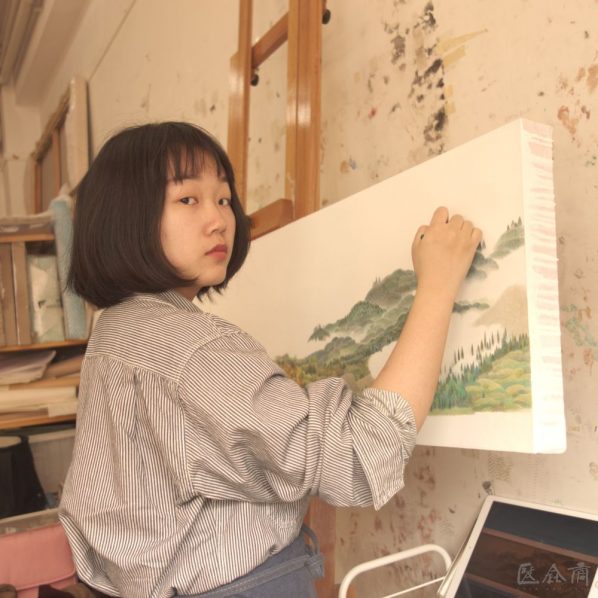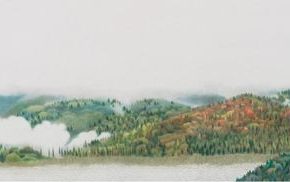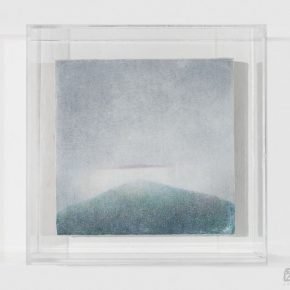
Wu Yi: This is very interesting. It is a bit like A Hundred Years of Chinese Oil Paintings: like writing a military history and then drawing it out. This type of conversation invites an excurse of graduates from different periods. Actually, it’s rooted in the dramatic changes that took place in the Chinese society in the past 30 years.
Zhang Wenzhi: As a starting point for our discussion today, Li Yewei, your work at the graduate exhibition is a colored pencil drawing made in ink and wash. If we look back at your work as an undergraduate, what kinds of pieces did you create? This is also a way to keep track of developments in thinking about your own work.Li Yewei: My undergraduate work shows a grove of orange trees in my hometown. I painted it with acrylic colors in an especially bright and lively way. My way of applying colors and materials is relatively free. It is similar to Mr. Wu’s. My current graduation project is made by colored pencils, which best conveys the effects of my feelings, but I still use acrylic at other times. In contrast, when I was an undergraduate, I was interested in creating a more visually powerful work. The orange I used in my painting was a big full-circle orange because I was worried that the small, or group paintings, would be “eaten” by the big paintings. However, I don’t worry about this much now because my painting is about me, it’s no longer about the size. People come here to see me. This graduate work is very realistic. I grew up in the south of China, so here I show the mountains of the south.
Zhang Wenzhi: Prof.Wu, you received your Bachelor’s degree in 1989 and your Master’s degree in 1993 from CAFA. What has changed during these two decades in your style? Given these changes, the current students are the result of a transformational process. What’s your perspective on this result?Wu Yi: To start with, China’s rapid economic development over the past 30 years has gradually standardized many social norms, and we can feel this change. The stability of the environment has an effect on people’s mood. The new artists sense that their work is a sincere dialogue with nature and withdraw into quietness. During my time, our education emphasized representing the formal schemas, even some seemingly strange schemas that conveyed a sense of violence. I think that the current students’ works tend to go back to the very nature of painting. They deliver a rational, accountable, and intrinsic meaning in their paintings.
Li Yewei: But does it mean that we are too concerned about “the self”?
Wu Yi: “Self” is a very broad concept. Something does not present as “self” but have a “self” in it. It's a different reflection of patterns. Some are long and some are short, with various levels of vitality inside them.
Zhang Wenzhi: If we go back in time, during your own graduation the New Wave Art was in full swing. What was your view on this trend while learning ink painting?Wu Yi: At that time, we rarely mentioned traditions. Instead, we emphasized the visual effects of ink paintings. It was at that time that the words “experimental ink painting” and “tension of ink painting” first started to be used in an attempt to severe the language of brush and ink from a traditional context. At that time, we still had artists who insisted on using traditional methods, but after many years this group shrank and these methods lead to a further rift. Mr. Lu Chen was correct when describing Chinese painting as a particularly complex system. Sometimes you want to maintain a “sense of distance,” but this so-called “sense of distance” is something you venture to experience in the West, and then strip it away from your work and return to tradition with an entirely new perspective on things.
Zhang Wenzhi: What did you experiment in the West and how did you distance yourself from this experience afterwards?Wu Yi: I remember an impressive exhibition that showcased the works of Tapies, a Spanish abstract painter, in Beijing. Artists like us, who work on ink paintings, perceived his abstract work as a type of ink painting, and we believed that Chinese ink painting could also follow his model. Then, a group of Chinese artists experimented with it and used this method in contemporary Chinese ink painting. After a few years of explorations, we suddenly felt that what we tried to accomplish was getting farther away from us. One becomes anxious, especially when too much time passes, so we realized that the time for producing this type of artwork hadn’t come yet. After experimenting with Western techniques, returning to our own tradition allowed us to create more insightful pieces of art. Li Yewei’s generation has made this clear. Therefore, it is actually not important to teach the students these things again. These are not problems of their time any more. I see students now painting better than us when we were students. Moreover, nowadays information is free and easily accessible. The thinking process of the new generation is modern and the nature of their knowledge has changed. For example, Li Yewei’s works have some of the feeling of Mi Fu’s ink painting, though her tools are different and she does not use brush and rice paper. But these are just trivial differences.
Zhang Wenzhi: You described how the changes of the times are reflected in contemporary painting. What was Chinese society like during your studies and after your graduation?Wu Yi: My graduation work is Shaanxi Group Painting. At that time, painting a realistic theme required an artist to experience life in rural areas. Therefore, in the last semester of my fourth year, I completed six acrylic and oil pastels in Suide, the northern Shaanxi Province, which depicted the autumn harvest and were all based on sketches of scenes that represented people and their environment. There are also scenes of marriage and playing the suona horn that I would like to come back to and enlarge in the future. However, I can't fully depict these scenes. Eventually, these six paintings in Northern Shaanxi became my graduation pieces. Such works are hardly seen within the works of Chinese painting students. When I finished graduate school, I exhibited works in different styles, including ink, pencil, and acrylic. None of them looks like the works of other students of Chinese painting. Although the main topic is conveyed through ink painting, they rarely use traditional brushstrokes. Many of these paintings are not even painted with brushstrokes; instead, in some of them I used oil paintbrushes, which are an influence of German expressionism. At that moment, I was young and wanted to detach myself from tradition. I believed that my skills and ideas must be completely different from those of previous artists’. Therefore, the exhibition of this series of works caused many controversies. Mr. Zhong Han once talked to Mr. Lu Chen about how Chinese paintings changed over time. However, society accepted this new style very quickly. In 1994, Liu Xiaochun curated an exhibition called "Tension Experiment" at the China National Museum of Art, and my works were exhibited there alongside the works of the artists I admired the most, such as Zhu Zhengeng and Yang Gang. That happened just after my graduation, and this is how I entered mainstream of ink painting.
Zhang Wenzhi: We all know that you have been involved in teaching murals. From ink painting to murals, what kind of development is this?Wu Yi: I’m not the kind of person who wants to try all kinds of paintings. I felt content staying in the mural painting department. If I joined the school of Chinese painting, I might lose my train of thought. I have never offered an ink painting course in the Mural Painting Department. Personally, I feel that there are still a lot of unknowns in mural studies. Also, I don't have a complete material package to discuss with my students. In the beginning, Mr. Sun Jingbo arranged for me to teach a traditional line drawing course that involved copying the Linyi Yongle Palace mural. There was a time when Mr. Chen Wenji was in charge and he asked me to teach this oil painting course because he thought I could inspire students to do oil painting with my special perspective.
Zhang Wenzhi: Although there are no ink painting courses in the department, I can still see that Li Yewei's work has an ink and wash feel. Without using the ink and wash techniques, how does that feeling come across?Li Yewei: I don't think ink painting should be like the Western oil painting or follow a particular methodology. It is very difficult to teach how to start an ink painting. I learned Chinese painting without any background knowledge. Not many students in our studio had such a background. For example, when we went to museums to see exhibitions of traditional Chinese paintings, we didn't understand them very well, we were just wandering around. We were not like the students from the school of Chinese painting, who were able to account for each of them. However, we still felt good about those works. I think it is more about the intrinsic aspect of the Chinese culture. Although we don’t paint like that anymore, we can still relate to the Chinese paintings due to the poetry we learned when we were young. Our supervisor asked us to practice calligraphy prior to entering the studio. We were the first group of students in the studio and everyone was very conscientious. During the summer vacations, everyone practiced calligraphy at home and, when we started to write with brush, it was good, we could feel it differently. After that, we copied some ancient paintings and Mr. Wu invited teacher Ma Qiang to give us a related course.
Wu Yi: Ma Qiang is my classmate at CAFA. Then he went to study at Kyoto City University of Arts, he became a specialist in the restoration of classical painting and now works at Dunhuang Academy. Ma Qiang taught the students the techniques he learned in Japan. This is another way to experience ancient paintings: by copying them by using those techniques. Why don’t I show my own practice when I am teaching? Sometimes, the style of the teacher can be an obstacle for students. Once they fall into their teacher's way of approaching things, they may not be able to remove themselves for many years. Therefore, I often give my students time to understand themselves, even if they are looking into the traditional knowledge of the Western painting; that can be a very interesting experience too. Later, I invited a professor from the School of Chinese paintings, Xu Hualing, to teach them. I feel her painting aura is particularly of interest to young people, and I don’t want my students who learn Chinese painting to start with ink painting. Since the Ming and Qing dynasty, everyone has emphasized brushstrokes and the relationship between the shapes and the spirit becomes diluted. What was perfect in the Song Dynasty paintings is the way they emphasize the beauty of shape. Teacher Xu Hualing gives students enough freedom in class to discover and understand their own ideas.
Li Yewei: I had a noticeable feeling when I started painting. The nose in my painting was based on the Western tradition of painting, and I unconsciously wanted to add a shadow in order to make it look more solid. Later, when we attended Professor Kanazawa Yuna’s course, she shared a similar experience. Once she began to do ink paintings after her arrival in China she based them entirely on her own interpretations. Her experience has very similar to ours. In our class, we did not paint in ink from the very beginning. Instead, she asked us to sort all our works from when we started our undergraduate courses. During that process I discovered the changes in my style and gradually became clear about my direction. After finishing my undergraduate course, I also began to use colored pencils.
As Mr. Wu said, the "Experiment of Tension" exhibition is particularly important for him. So are we, as our works are also showcased in the exhibition after we finished our teacher’s course. If my exhibition, my pieces have received positive feedback, I will be even more determined to explore this direction in painting. So, I think this exhibition is, indeed, very important. Professor Wu also emphasized that, in addition to painting, we must get in touch with our audience and let them judge our work.
Wu Yi: The artists’ self-confidence is often based on the feedback they receive from the public, and artists have little self-confidence at this time. The process of enjoying the painting is a way of bringing the same feeling to the audience. This year's graduation works of the Mural Painting Department are quite interesting. Rather than a single type of painting, it is an open-ended exhibit that investigates future possibilities.
Zhang Wenzhi: Now that we have entered a new era, how do we understand the art form of mural painting?Wu Yi: Ten years ago, people said that the Mural Painting Department should be called the Department of Free Arts. Given its free and open status, the most important aspect of mural paintings is its social function. The creation of mural paintings is based on the idea of free art and should never cease to show its vitality.
Zhang Wenzhi: Looking at your graduation work, I feel that the style of your later works is still quite different. Can you tell us how this has changed?Wu Yi: I follow the changes of the times. The times behind us changed, so my paintings also changed. Just as we see in this year’s graduation output, these paintings will also change to reflect the changing times. However, these changes won’t be as dramatic as ours as the structure of paintings is now established, unlike in the past, when we were still trying to discover it.
Li Yewei: Because we have a relatively stable life, when our teachers comment on our works, they say that current students are more self-conscious, meaning that they paint their own small world, or their own growth. I think that, because our lives are stable, we have always been in touch with the society we live in.
Wu Yi: Actually, CAFA had a similar experience. In 1995, CAFA moved from the Wangfujing location to the Second Factory. The ruins of the university provided a feeling of dramatic social change to people. These things will affect artists’ paintings.
Zhang Wenzhi: From the graduation pieces of Wu Yi, more than two decades ago, to the graduation pieces of Li Yewei today, we can see many changes in style. Professor Wu, how do you evaluate these changes from a professional perspective?Wu Yi: We rarely talk about how the painting works. In her graduation project, Li Yewei has distanced herself from tradition and presented her hometown scenery from her own perspective. At the same time, she incorporates in her work both contemporary and traditional artistic concepts, which complicates the two. The only regret I have is that her treatment of water is too hasty due to the limited time she had, but this is just one piece of work in the wider spectrum of her artistic life. The road ahead is long and full of great expectations.
Text by Zhang Wenzhi, translated by Yao Yue and edited by Sue/CAFA ART INFO
Photo Courtesy of the Artists



















































